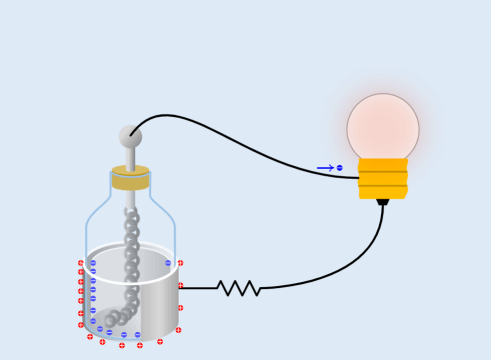Leyden Jar
The Leyden Jar is a tool (capacitor) created in the 18th century for storing static electricity. The Leyden Jar is made of glass, with metal foil surrounding the inside and outside of the bottle.
The two thin metal foils are placed close enough to touch each other but are separated by glass. Therefore, the charge from one foil cannot jump to the other. The two metal foils have different charges when the Leyden Jar is charged.
The amount of charge that the Leiden bottle can hold is smaller than expected. For example, a Leyden Jar with an internal capacity of about 500 mL has about \(1nF\) (\(1 \times 10^{-9} F\)). Today, the same capacitor can be made the size of a grain of rice.
Charging of the Leyden jar
The inner foil of the Leyden Jar is connected to the central terminal through a material that allows current to flow, such as a chain. When positive charges (or negative charges) flow through this terminal, the inner metal foil becomes charged.
Because the outside of the Leyden Jar is grounded, it is charged with a different charge from the inner foil due to electrostatic induction.
When the Leyden Jar is charged, it tends to remain charged due to the force of attraction between charges of different polarities.

Disappearance of stored charge (discharge)
Charges can flow when the terminals and the outer metal foil are connected through an electric circuit. The charges flow along the electric circuit due to the potential difference (or voltage). When discharged, the energy contained in the charges is released in various ways. For example, lightning may flash in the clouds, or sparks may come from your fingertips when you touch metal on a dry day.

